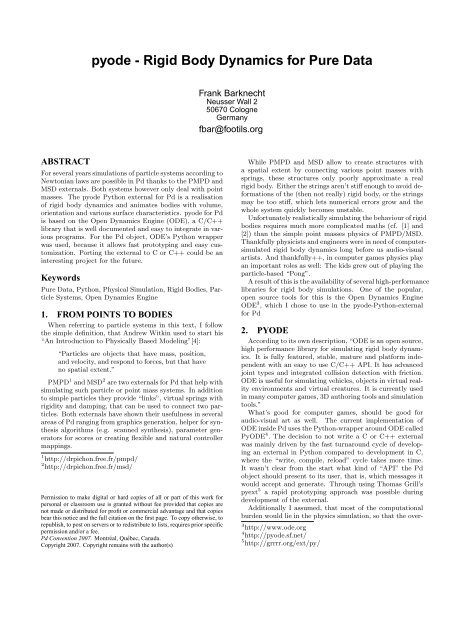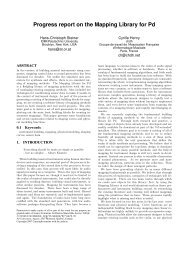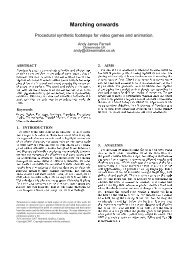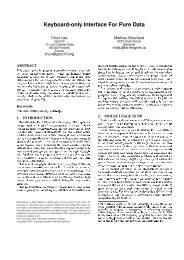pyode - Rigid Body Dynamics for Pure Data - Artengine
pyode - Rigid Body Dynamics for Pure Data - Artengine
pyode - Rigid Body Dynamics for Pure Data - Artengine
Create successful ePaper yourself
Turn your PDF publications into a flip-book with our unique Google optimized e-Paper software.
<strong>pyode</strong> - <strong>Rigid</strong> <strong>Body</strong> <strong>Dynamics</strong> <strong>for</strong> <strong>Pure</strong> <strong>Data</strong><br />
Frank Barknecht<br />
Neusser Wall 2<br />
50670 Cologne<br />
Germany<br />
fbar@footils.org<br />
ABSTRACT<br />
For several years simulations of particle systems according to<br />
Newtonian laws are possible in Pd thanks to the PMPD and<br />
MSD externals. Both systems however only deal with point<br />
masses. The <strong>pyode</strong> Python external <strong>for</strong> Pd is a realisation<br />
of rigid body dynamics and animates bodies with volume,<br />
orientation and various surface characteristics. <strong>pyode</strong> <strong>for</strong> Pd<br />
is based on the Open <strong>Dynamics</strong> Engine (ODE), a C/C++<br />
library that is well documented and easy to integrate in various<br />
programs. For the Pd object, ODE’s Python wrapper<br />
was used, because it allows fast prototyping and easy customization.<br />
Porting the external to C or C++ could be an<br />
interesting project <strong>for</strong> the future.<br />
Keywords<br />
<strong>Pure</strong> <strong>Data</strong>, Python, Physical Simulation, <strong>Rigid</strong> Bodies, Particle<br />
Systems, Open <strong>Dynamics</strong> Engine<br />
1. FROM POINTS TO BODIES<br />
When referring to particle systems in this text, I follow<br />
the simple definition, that Andrew Witkin used to start his<br />
“An Introduction to Physically Based Modeling”[4]:<br />
“Particles are objects that have mass, position,<br />
and velocity, and respond to <strong>for</strong>ces, but that have<br />
no spatial extent.”<br />
PMPD 1 and MSD 2 are two externals <strong>for</strong> Pd that help with<br />
simulating such particle or point mass systems. In addition<br />
to simple particles they provide “links”, virtual springs with<br />
rigidity and damping, that can be used to connect two particles.<br />
Both externals have shown their usefulness in several<br />
areas of Pd ranging from graphics generation, helper <strong>for</strong> synthesis<br />
algorithms (e.g. scanned synthesis), parameter generators<br />
<strong>for</strong> scores or creating flexible and natural controller<br />
mappings.<br />
1 http://drpichon.free.fr/pmpd/<br />
2 http://drpichon.free.fr/msd/<br />
Permission to make digital or hard copies of all or part of this work <strong>for</strong><br />
personal or classroom use is granted without fee provided that copies are<br />
not made or distributed <strong>for</strong> profit or commercial advantage and that copies<br />
bear this notice and the full citation on the first page. To copy otherwise, to<br />
republish, to post on servers or to redistribute to lists, requires prior specific<br />
permission and/or a fee.<br />
Pd Convention 2007. Montréal, Québec, Canada.<br />
Copyright 2007. Copyright remains with the author(s)<br />
While PMPD and MSD allow to create structures with<br />
a spatial extent by connecting various point masses with<br />
springs, these structures only poorly approximate a real<br />
rigid body. Either the strings aren’t stiff enough to avoid de<strong>for</strong>mations<br />
of the (then not really) rigid body, or the strings<br />
may be too stiff, which lets numerical errors grow and the<br />
whole system quickly becomes unstable.<br />
Un<strong>for</strong>tunately realistically simulating the behaviour of rigid<br />
bodies requires much more complicated maths (cf. [1] and<br />
[2]) than the simple point masses physics of PMPD/MSD.<br />
Thankfully physicists and engineers were in need of computersimulated<br />
rigid body dynamics long be<strong>for</strong>e us audio-visual<br />
artists. And thankfully++, in computer games physics play<br />
an important roles as well: The kids grew out of playing the<br />
particle-based “Pong”.<br />
A result of this is the availability of several high-per<strong>for</strong>mance<br />
libraries <strong>for</strong> rigid body simulations. One of the popular,<br />
open source tools <strong>for</strong> this is the Open <strong>Dynamics</strong> Engine<br />
ODE 3 , which I chose to use in the <strong>pyode</strong>-Python-external<br />
<strong>for</strong> Pd<br />
2. PYODE<br />
According to its own description, “ODE is an open source,<br />
high per<strong>for</strong>mance library <strong>for</strong> simulating rigid body dynamics.<br />
It is fully featured, stable, mature and plat<strong>for</strong>m independent<br />
with an easy to use C/C++ API. It has advanced<br />
joint types and integrated collision detection with friction.<br />
ODE is useful <strong>for</strong> simulating vehicles, objects in virtual reality<br />
environments and virtual creatures. It is currently used<br />
in many computer games, 3D authoring tools and simulation<br />
tools.”<br />
What’s good <strong>for</strong> computer games, should be good <strong>for</strong><br />
audio-visual art as well. The current implementation of<br />
ODE inside Pd uses the Python-wrapper around ODE called<br />
PyODE 4 . The decision to not write a C or C++ external<br />
was mainly driven by the fast turnaround cycle of developing<br />
an external in Python compared to development in C,<br />
where the “write, compile, reload” cycle takes more time.<br />
It wasn’t clear from the start what kind of “API” the Pd<br />
object should present to its user, that is, which messages it<br />
would accept and generate. Through using Thomas Grill’s<br />
pyext 5 a rapid prototyping approach was possible during<br />
development of the external.<br />
Additionally I assumed, that most of the computational<br />
burden would lie in the physics simulation, so that the over-<br />
3 http://www.ode.org<br />
4 http://<strong>pyode</strong>.sf.net/<br />
5 http://grrrr.org/ext/py/
head of running a Pd object through Python would be negligible<br />
compared to that. The Python wrapper <strong>for</strong> ODE in<br />
the end will compute the physics simulation through the<br />
C/C++ library anyways, so it should be of comparable<br />
speed. But I admit, that I didn’t run any comparison benchmarks<br />
yet.<br />
3. ODE IN PD<br />
Typically simulations of particle systems have to deal with<br />
four tasks:[3]<br />
• Creation<br />
• Termination<br />
• Animation<br />
• Visualisation<br />
It seems sensible to start with a similar approach when<br />
structuring the implementation of rigid body systems.<br />
3.1 Creation<br />
Creation is at the beginning: A world with various parameters<br />
like gravity or air drag has to be defined. The<br />
world then needs to be populated with bodies, that have<br />
various characteristics as well. In MSD these bodies are all<br />
point masses. Their only difference is the initial position and<br />
their mass. <strong>Rigid</strong> bodies however additionally have a shape<br />
and an orientation and possibly a surface friction, that have<br />
to be defined as well.<br />
Creation in <strong>pyode</strong> <strong>for</strong> Pd is handled in a similar fashion<br />
as in MSD: A single Pd object holds a complete world of<br />
physical bodies. Bodies are created through messages to<br />
one of the object’s inlets. A message to create a body may<br />
look like this: “body box MyBox 0 10 0 90 0 1 0 1000 1 0.1<br />
2”. Help <strong>for</strong> the parameters of a message can be accessed<br />
by reading the “docstring” of this method in <strong>pyode</strong> <strong>for</strong> Pd.<br />
For the “body”-message this gives:<br />
shape: box, sphere, etc.<br />
id: a name <strong>for</strong> the body, used as a key in<br />
self.bodies. Has to be unique.<br />
Position of center: x, y, z<br />
Orientation: angle (deg), rx, ry, rz<br />
args: further properties of the body, that will<br />
get passed to a method ’”self.create %s” %<br />
shape’.<br />
Use this to set special properties like density,<br />
size of a box, radius of a sphere etc.<br />
As ODE provides several possible body-types like box,<br />
sphere, cylinder or even a triangle mesh, the implementation<br />
will automatically search <strong>for</strong> a special “create X”-method, if<br />
it receives a “body X ...” message, and then calls “create X<br />
with the supplied parameters (using Python’s ”getattr“ function).<br />
A message ”body box ...“ will look <strong>for</strong> ”create box“,<br />
a message ”body cylinder ...“ will look <strong>for</strong> ”create cylinder“.<br />
If the method doesn’t exist, an exception will be raised and<br />
an error will be printed to Pd’s console.<br />
Similar message-methods are available to create what ODE<br />
calls ”geoms“ (geometry objects similar to bodies but without<br />
a mass) or to influence parameters of the contained<br />
world.<br />
Figure 1: Example patch illustrating how to populate<br />
the ODE-world with some boxes and a sphere.<br />
3.2 Termination<br />
Termination has to deal with removing objects from the<br />
world again after they’ve reached a certain age. This is<br />
not currently implemented in <strong>pyode</strong>, but a ”delete body“<br />
method is planned.<br />
3.3 Animation<br />
Animation then is the phase, where the behaviour of the<br />
world and the contained actors is simulated according to the<br />
rules and differential equations of a dynamics system. The<br />
simulation looks at all the bodies’ positions, velocities (both<br />
angular and global), accelerations, <strong>for</strong>ces and collisions, and<br />
then steps the whole world one time-step further, while calculating<br />
the effects of speeds, <strong>for</strong>ces, collisions etc. on the<br />
bodies and geometries.<br />
Advancing the world simulation in Pd is done through a<br />
”bang“-message. The corresponding Python method basically<br />
just asks ODE’s ”quickStep“ method to do all necessary<br />
calculations.<br />
3.4 Visualisation<br />
In <strong>Pure</strong> <strong>Data</strong>, Visualisation may also mean sonification<br />
or something more exotic. From a pure-data-centric point<br />
of view visualisation just are the messages, that leave the<br />
<strong>pyode</strong> object’s outlets. In my implementation the messages<br />
are lists: After every simulation step is complete, the positions,<br />
speeds etc. of all existing bodies is sent to <strong>pyode</strong>’s<br />
outlet. Drawing an ODE body <strong>for</strong> example will return a list<br />
composed of:<br />
• Position (3): x,y,z<br />
• Orientation (4): angle, rx, ry, rz<br />
• Shape-specific data: e.g. size <strong>for</strong> a box as a<br />
list of 3 lengths.<br />
Several ready-made Pd abstractions that are part of the<br />
<strong>pyode</strong> <strong>for</strong> Pd distribution simplify parsing these lists (which
Figure 2: Helper abstraction ode box.pd to render<br />
boxes.<br />
Figure 3: Gem rendering the example patch.<br />
can get quite verbose) and can automatically map them to<br />
commands <strong>for</strong> Gem-objects like [translateXYZ].<br />
The abstraction ode bodyinfo.pd contains a chain of [list<br />
split] operations that distributes data common to all bodies<br />
(like position vector, angle and vector of rotation) to various<br />
outlets, and it passes the specific data like the radius<br />
of a sphere along to the last outlet. It is used in bodyspecific<br />
rendering abstractions, <strong>for</strong> example ode box.pd, to<br />
finally make rendering of various bodies in GEM easy. The<br />
rendering abstractions like ode box.pd only modify the current<br />
GEM pointer and they don’t contain final primitives<br />
<strong>for</strong> rendering. This way it still is possible <strong>for</strong> example to use<br />
an OpenGL cube <strong>for</strong> displaying what in ODE is modelled<br />
as a sphere. The rendering objects automatically render as<br />
many copies of a body as necessary using <strong>for</strong>ced rendering<br />
in GEM with a ”double gemhead“.<br />
a certain direction and a certain range - without breaking -<br />
and just like a human head can do different movements, different<br />
joints in ODE have different characteristics. Because<br />
of this Joints need to be chosen carefully. In the <strong>pyode</strong>-<br />
Pd object joints are created with special messages similar<br />
to the creation of bodies. One of the possible types has to<br />
be selected as well as the bodies to connect with a joint.<br />
For example a ”ball“ joint always has a constant length and<br />
allows twisting movements in all direction, a ”hinge“ joint<br />
restricts torque to one direction only, while a ”slider“ joint<br />
doesn’t allow <strong>for</strong> torque, but it can change its elongation.<br />
Contact joins are a group of special joints that are automatically<br />
created and deleted, when two objects touch each<br />
other. These are used internally <strong>for</strong> the collision detection,<br />
which is active as default. Through various messages to the<br />
<strong>pyode</strong> object, parameters <strong>for</strong> the collision, like the bounciness<br />
of a collision, can be set while the simulation is running.<br />
Similar to the abstractions <strong>for</strong> bodies, a set of abstractions<br />
to make rendering joints with GEM easier is included.<br />
5. FUTURE<br />
The prototype of <strong>pyode</strong> <strong>for</strong> Pd so far is working fairly<br />
well. Per<strong>for</strong>mance-wise it doesn’t seem to be necessary to<br />
go with a C/C++ external <strong>for</strong> now, as the Python version<br />
can easily calculate about 100 bodies on my test machine, a<br />
AMD Athlon64 Processor 3000+. Still a respectable part of<br />
the ODE-API doesn’t have an equivalent in <strong>pyode</strong> <strong>for</strong> Pd,<br />
especially Motors are completely missing. Filling the holes<br />
is planned <strong>for</strong> the near future.<br />
6. REFERENCES<br />
[1] D. Baraff. An introduction to physically based<br />
modeling: <strong>Rigid</strong> body simulation 1: Unconstrained<br />
rigid body dynamics.<br />
http://www.cs.cmu.edu/~baraff/pbm/rigid1.pdf,<br />
1997.<br />
[2] D. Baraff. An introduction to physically based<br />
modeling: <strong>Rigid</strong> body simulation 2: Nonpenetration<br />
constraines.<br />
http://www.cs.cmu.edu/~baraff/pbm/rigid2.pdf,<br />
1997.<br />
[3] G. Trogemann and J. Viehoff. CodeArt. Springer, Wien<br />
[u.a.], 2005.<br />
[4] A. Witkin. An introduction to physically based<br />
modeling: Particle system dynamics.<br />
http://www.cs.cmu.edu/~baraff/pbm/particles.pdf,<br />
1997.<br />
4. JOINTS INSTEAD OF LINKS<br />
ODE holds a surprise <strong>for</strong> users of the PMPD/MSD externals<br />
when it comes to creating links between masses. ODE<br />
doesn’t just have one catch-all link type, instead it provides<br />
various kinds of Joints. Joints restrict the possible degrees<br />
of freedom when moving a body that is joined with another<br />
body. Just like a finger on a human hand can only move in







